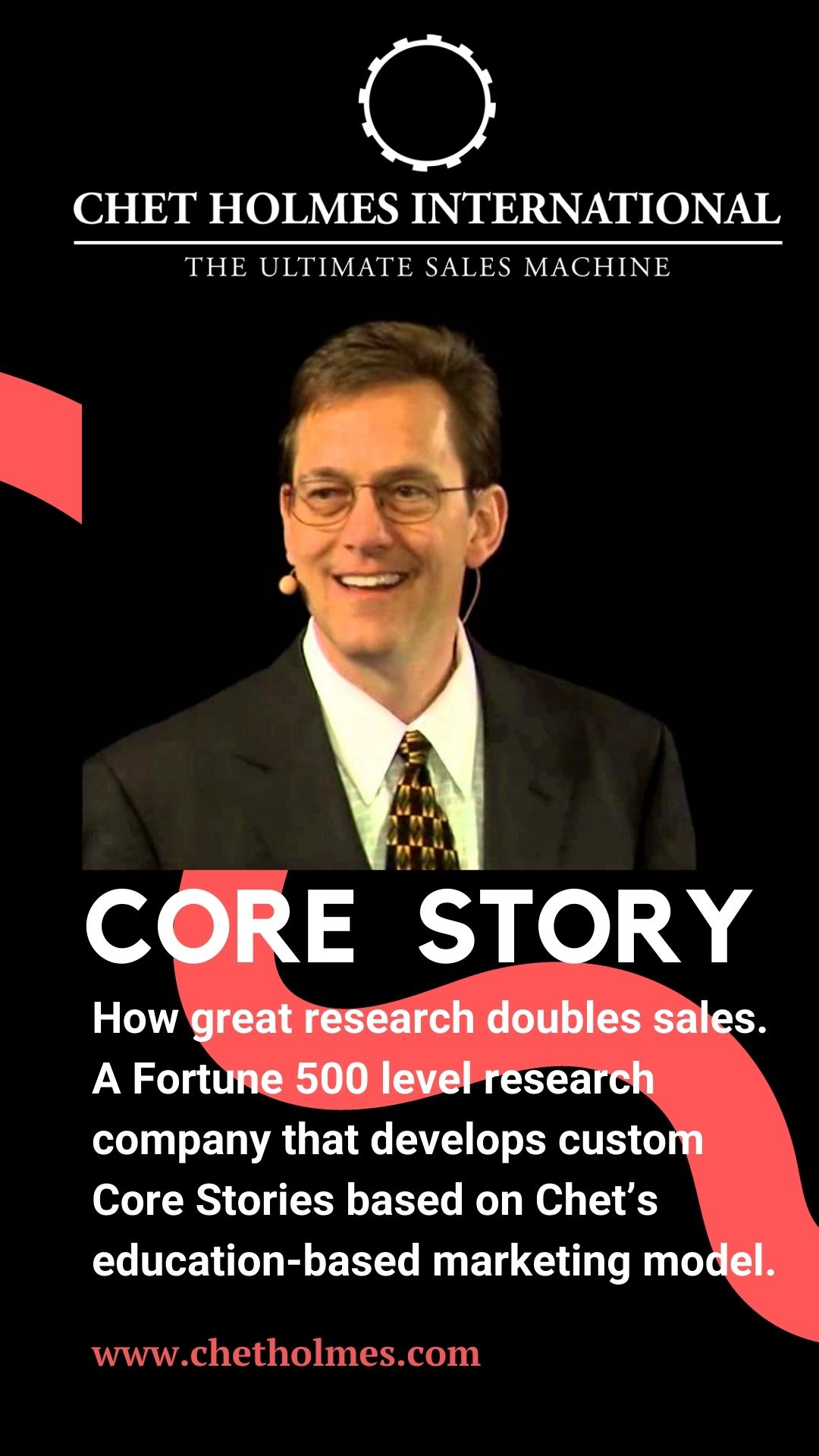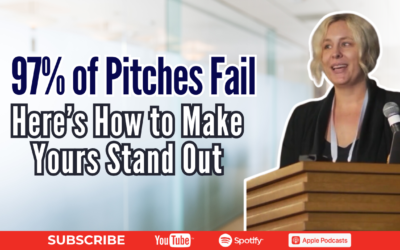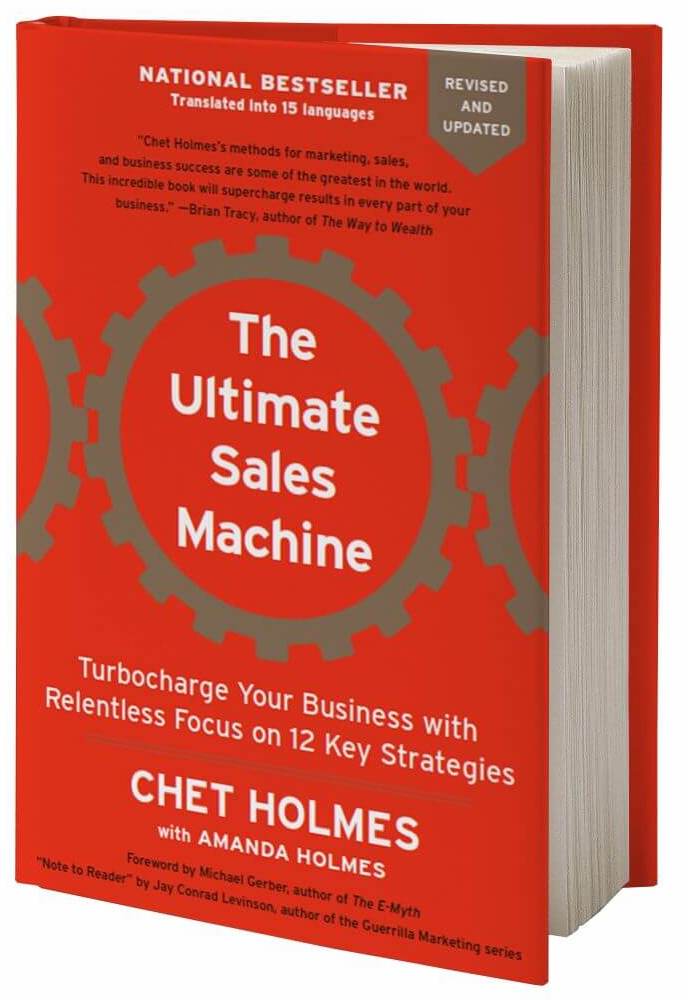Did you know that a staggering 95% of businesses never reach the coveted million-dollar mark in revenue?
If you’re one of the few who’ve achieved this milestone, congratulations – you’re practically a miracle!
But the journey doesn’t stop there.
Only .8% make it from 1 million to 5 million.
Your odds improve to 1.5% make it from 5 million to 10 million.
And a mere .004% make it to a 100 million and beyond.
Now, you might be wondering, “What separates these successful 9-figure businesses from the rest?”
In this week’s episode, we talk about the 4 marketing mistakes that companies make when trying to get from seven to nine figures.
We’ll share valuable strategies and insights that can help you grow your business effectively and navigate the challenges that come your way.
Stay tuned until the end because we’ll cover a four-part framework of the Ultimate Sales Machine that can assist you in getting hyper-focused in doubling your business revenue.
P.S. We can help you build your Ultimate Sales Machine framework! Don’t miss out on this opportunity–schedule your complimentary no obligation consultation today at HowToDoubleSales.com
Continued Learning: Best Marketing and Sales Advice from Jay Abraham and Chet Holmes
- Want to know what’s keeping you from doubling your sales in the next 12 months? Take our quick QUIZ to get answers: Howtodoublesales.com
- If you’d like to have a profound breakthrough in your business, schedule your breakthrough call with a LIVE expert here: Chetholmes.com/Breakthrough
- Claim your FREE chapter 4 from the top 10 most recommended marketing and sales books of all time! Visit: Ultimatesalesmachine.com to find out how you Create 9X More Impact from every move you’re already making to win clients!
TRANSCRIPT:
*this transcript was mostly generated by AI, please excuse any mistakes 
Amanda: [00:00:00] Hello and welcome to the CEO Mastery Show. Amanda Holmes here, your host. This week we are talking about how to dodge the million dollar marketing mistakes.
Here is your dose of the ultimate sales machine coming to you from the new edition, visit ultimate sales machine. com to get your copy or multiple copies. I am your host, Amanda Holmes, CEO of Chet Holmes International. What you’re about to learn has assisted a quarter of a million businesses to generate billions of dollars working faster, better, smarter.
Amanda: So, 95 percent of businesses never make it to a million. If you’ve made it to a million, you are practically a miracle. Of those that make it to a million, 0.
8 percent make it to 5 million, and then your chances improve from 5 million to 10 million. It increases by 1. 5, 1. 5 percent of companies make it to 10 million, and 0. 004 percent of companies make it to 100 million and beyond.
I am so blessed enough to be able [00:01:00] to work with over the last 10 years, taking over the ultimate sales machine, hundreds of companies that are in the seven figures trying to get to eight, in the eight figures trying to get to nine, in the nine figure low trying to get to the higher nine figures. And we see over and over again the same mistakes. We’ve assisted a quarter million businesses worldwide on how to double sale.
So I’m just gonna give you… Here are the places where you have huge… Gaping holes in your strategy. This is why you’re wasting time, money, energy. It’s these four things that I’m about to reveal.
The first marketing mistake that companies make when trying to get from seven to nine figures is number one Aimless pursuits. Do you think just by dreaming you’re gonna get there because 95 of small businesses Never have a yearly goal 95%. That is shocking. I will tell you, I experience it every day, so we see it [00:02:00] every day.
Uh, and small business as defined by a company below 50 million. So, do you have a goal? And even those, the 5 percent that do have a year’s goal, only 5%. 5 percent of that actually achieve it. Oh, why? Probably because they haven’t divided it down into, okay, if I have a year’s goal, this is what that looks like per quarter.
This is what that looks like per month. This is what that looks like per week. For those of you that don’t do that, I highly recommend it. But aimless pursuits. I was just on a call. a couple days ago with a 20 million, 23 million company. And I had the CEO and the head of sales on and the CEO, I asked him, you know, what’s your goal this year for this particular product offering?
And he didn’t know he had no idea. And he bunted it to his head of sales. And he also kind of said, well, yeah, we want to grow. Oh, okay. How much would you like to grow? You know, [00:03:00] and just kind of pulling out from him, Okay, maybe it’s, uh, I don’t know, maybe, uh, Double digits, okay, well we’ve grown this much over the years, Okay, so would you like to continue that much?
Okay, what would that look like? Okay, give me an idea of your average transaction value. Okay, so you’d need X number of sales at this amount of revenue to achieve that goal that you’re looking for. Okay, great. I wasn’t trying to pry, I was just trying to better understand what their goals were so I could assist.
And I can see why so many marketing companies completely fail when working with staff, because… They’re usually one of the big reasons is they’re not alignment in the goals But it’s also because the clients just don’t even have goals They haven’t they haven’t gone clear on or maybe one person has a goal and then the rest of the team doesn’t have the goal So if everyone is in misalignment for what that goal truly is Maybe some have limiting beliefs around what that goal should be.
Others have somewhat of a [00:04:00] goal, but they haven’t stuck to it, or they’ve said it out loud once, or they were afraid to say it out loud. There’s so many different layers to this. And I, almost every time I say, Okay, let’s do a goal setting workshop, the majority of people roll their eyes. Okay, here we go again.
But it’s such a huge problem. If we don’t know where you’re going, how can we help you get there? Aimless pursuit.
So remember, implementation, not ideas, is the pathway to success, but we have to know where that end goal is to be able to implement.
The second marketing mistake that companies make when trying to get from 7 to 9 figures and beyond is… Drumroll please… Number 2. Customer chaos.
Did you know that only 40 of companies actually make a profit? That means that majority, 60 of companies are either breaking even or losing money.
So, it’s shocking if you were in a room full of 10 business owners. If you look around, majority of them are in a tough spot. We [00:05:00] see it all day, every day. You may have a one man army. One woman army that’s forcing their way, brute force, up until that million dollar mark and they’re probably making more profits than the eight figure CEO that’s got a ton of staff and is barely keeping the lights on and stressed out in their mind trying to make it happen.
I’ve experienced it myself. It’s a stressful place. So what can we do to increase that bottom line and increase our profitability? I’ll tell you right now. Stop working with clients that either are break even or losing you revenue. Just stop doing it. I hear from a lot of companies that are very referral based.
Well, you know, they come to me, and it’s a referral, and you know, I could just get that sale, and it’ll pay for some things. When we are reactive, right, we’re reactive all the time, we’re not going to be able to grow and scale. We need to be proactive. So… If you have those companies that you know is not an ideal client, what can [00:06:00] you do to create a strategic partnership with somebody that does serve that clientele?
And how can you refer them business and get a percentage of it? Then you don’t have to deal with it. Find a way to get smarter about who you’re working with. And another exercise that we do with nearly every client that comes into our core story division, is we ask them, Okay, pull up a list of all of the clients that you worked with the last year and how much money they’ve spent with you.
And let’s analyze that list. And I can’t tell you how much of the time we see majority of it are clients that are barely making a profit or break even or losing cash.
So let’s get hyper focused on who not to work with. Who do you not, who should you not work with? That also includes clients that are not good for your product or service, where it just doesn’t serve them, so they’re unhappy.
Stop working with them. It’s doing you a disservice to continue to serve [00:07:00] people that you can’t serve appropriately. So let’s look back, take some time to think about this. Who is not an ideal client, write it down, and then how can you reinforce a process? Not just you, but your entire team on how to get rid of that.
I’d also probably recommend looking at dream 100 or our course on the fastest, least expensive way to double sales.
Customer chaos is cutting through your profits more than you realize.
The third marketing mistake that companies make when trying to get from seven figures to nine figures is… Number three. Bland messaging that fails to engage.
So what am I talking about here? Tacticians versus strategists, right? If you are just hyper focused on, I just need to get a sale.
I just need to get a lead. I just need to get the appointment. Then you’re. Solely focused on what you want. Me, we, syndrome. Me, me, me, me, me. What we need to do is speak to what’s keeping your prospect up at night. It’s the stadium pitch. It’s the buyer’s pyramid. If you haven’t [00:08:00] seen chapter four of the ultimate sales machine, I highly recommend it.
It’s free out there. Chapter four. It’s all about how do I speak to those that aren’t thinking about me, think that they’re not interested, or definitely not interested, which is nine times more prospects that you could be getting in the door with every tactic you deploy if you just spoke to the painful problem that they are experiencing.
Okay, I’ll give you an example.
We had a client that sold bathroom fans. Now, they were in the low eight figures and they were trying to, they had aspirations to get through nine figures. Now, tactically, and, you know, this is in manufacturing, so it was so much a tactical conversation. Very much the whole sales process was more about order takers, right?
And what can I do to order another fan? I just want another fan. He was a brilliant… brilliant strategist. Instead of talking about fans, he started talking about trends, industry trends that are happening, the three [00:09:00] biggest trends you need to know about housing and home improvement, and how to capitalize on it for years to come.
That was his stadium pitch. So instead of coming in saying, hey I want to talk to you about IAQ, indoor air quality, and how to get more air through your units, No, let’s talk about what’s happening in their marketplace right now. What are the trends happening in the U. S. economy when it comes to housing?
What’s happening with the rise in smart homes? And what do millennial buyers want because so much more of them are buying today? And how is that different from the baby boomer generation and the generation X? And we’ve got a million dollars worth of market data to show you the trends and it’ll only take 19 minutes to discuss it with us.
So he took this kind of messaging, talking to what’s going on for builders and contractors, and led with an education at trade shows. He became one of the top leads generated at a trade show for the Home Builders Association, which is one of the biggest trade shows in the world. In [00:10:00] that particular industry and they got more leads than the multi million dollar booths that had much bigger They were one of the smaller booths.
Why? Because he led with an education that was important and relevant to his prospects They used it with their marketing reach. They used it with their ads. They used it with their newsletter, they used it everywhere.
So that’s what we call a core story. How can you educate your prospects to lead them to you as the only logical conclusion.
This is a huge place where you losing so much money and keeping money on the table.
The fourth marketing mistake that companies make when trying to get from seven figures through nine figures and beyond is number four, Wasted marketing channels. I can’t tell you how often this is a problem. So 15 years ago, best in class marketers would be on 7 different marketing channels. Today, the best in class B2C marketers are on[00:11:00] 15 different marketing mediums, different marketing tactics.
Then they are on another 8 social media platforms with five paid advertising sites. We’re doing double, almost triple the amount of work we were doing 15 years ago because there’s all these different mediums with the advent of technology and online media, right? Uh, technology has taken such huge strides from 15 years ago.
But then that leaves us spending all this time, money and energy on platforms that actually don’t apply to where our ideal customers are. And I’m going to give you an example of that. So we had a real estate broker who came in to us recently and they were asking, they said that they spent $10,000 a month on ads that went on buses.
Now they were selling multi million dollar homes. Do you think a multi million dollar home owner Spends time on buses.[00:12:00]
Instead, what if you do a Dream 100 Best Neighborhood Strategy where you just focus on where are the 100, 400 homes that are multi million dollar homes and you send direct mail to them. That could cost you, I don’t know, anywhere, a thousand, two thousand, three thousand dollars, depending on how you’re doing that direct mail.
2, 000 to 3, 000 hyper focused to get right in front of your ideal client versus pie in the sky, hoping that a multimillionaire will see the bus.
And what does that say to a multimillion dollar homeowner that you’re on buses, very interesting. So you could save 7, 000 a month if you stopped.
Marketing places where your prospects aren’t, and only focused on places where they are. I can tell you another example. We had a trade, we had a client that invested in trade shows. And there was one big trade show a year, and they would spend 90 percent of their marketing budget [00:13:00] on this one trade show.
Everything else was much smaller in comparison. And yet when we actually did an analysis of this, we found out that they generated 0 percent ROI. Like it was the biggest spend in their marketing suite and yet nothing. I mean like pennies on the dollar back. It was horrendous. So we need to get hyper clear on, first you have to know who your ideal client is because if you know who they are, then you can focus on where they spend their time and just being in their face and their place in their space.
So now I’ll break down the four part framework of the ultimate sales machine. How to be the most effective in your marketing and sales strategy when you’re deploying out your campaigns. The first step is you need to know where you’re going. You need to define your goal very clearly because if we know where you’re going, if you know where you’re going, it’ll be a lot easier to get there.
Step number two, you have to know who will get you to your goal the [00:14:00] fastest. It’s not going to be, you know, working with all these clients that generate you next to no profit. It’ll probably be ones that generate you more, more often, right? Think about Dream 100. So, who are the people that are going to get you to your goal the fastest?
Step number three, what do you need to say to get in the door? Okay?
More doors more often, right? That’s around that education based marketing.
And then step number four, where do you need to say it? That is exactly where those better buyers spend their time so that you can be in their face, in their place, in their space.
Okay? So I recommend this if this helps you. So you just have that four part framework take down on a piece of paper right now and draw four squares all next to each other in a line or squares above the first one, right goal. Above the second one, right? Who? Above the third one, what to say? And over the fourth square, [00:15:00] where?
I challenge you to fill in that four part framework. What’s your goal? Who do you need to get there the fastest? What do you need to say to get in more doors? And where do you need to say it to get the highest ROI and the biggest bang for your buck? That is our four part framework.
If you need help figuring out that four part framework, I will tell you we have huge transformations. In less than 20 minutes, talking to somebody about their four part framework to find holes, to find discrepancies, to find places where you are wasting a ton of money, an opportunity for you to have massive growth.
I was talking with a gentleman recently who assists. It’s actually in our boot camp. He assists, um, people that have gone through, or people that are going through IVF. It’s actually half. 50 percent of people that go through IVF don’t actually end up having a baby. And it’s stressful. It’s so painful. You want, you want to have a child so bad and you spend a small fortune to make that happen only to land a baby.
with not having a [00:16:00] baby. Now, he has a process that assists IVF patients to be able to increase that likelihood by something like 32 percent or 40%. It’s, it was a shocking amount for the amount of investment. So they help facilitate IVF, um, patients to have that success and to have a wonderful birthing experience.
Now they were going direct to consumer, And after a very short, I mean five minute conversation, we came to realize that they would be way more effective to just focus on all the IVF clinics in their area. The IVF clinics are already finding their ideal clients. The IVF clinics want to have successful patients.
It’s an additional revenue source for them if they refer them business. So we changed their approach to just focus on their ideal clients. And bam, they’re off to the races. I can’t wait to hear next week they’re supposed to report back to me how it’s gone. They targeted just 12 IVF clinics. But [00:17:00] one IVF clinic could get them 10 clients, 20 clients, right?
Instead of spray and pray trying to find who is trying to, uh, is having a problem with pregnancy and who is going after IVF. So much more difficult, right? This is how we get hyper focused in just a short period of time. We can find those holes and gaps in your four part framework to double your sales in the next 12 months.
It’s the ultimate sales machine framework. If you need help with that, go to howtodoublesales. com, howtodoublesales. com, fill out the information and you could have a no obligation. No selling, just pure value. Let’s figure out how to fill in those four boxes on your piece of paper, the four part framework on how to double your sales in the next 12 months.
And that is this week’s episode of the CEO mastery show.





 Get your pre-sale copy of the new edition of The Ultimate Sales Machine! (With special limited time bonuses)
Get your pre-sale copy of the new edition of The Ultimate Sales Machine! (With special limited time bonuses)
0 Comments